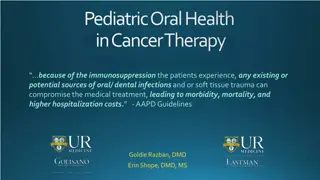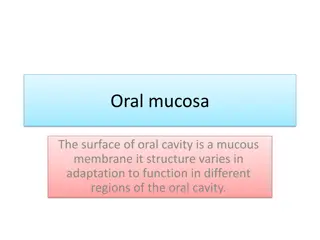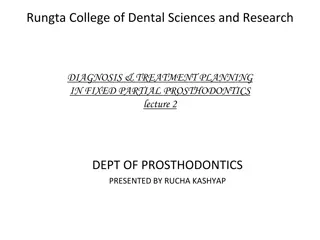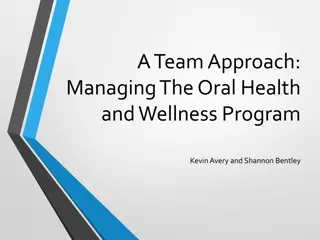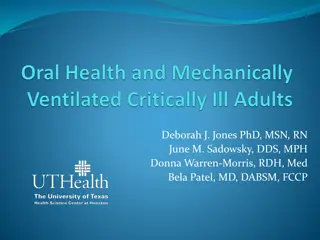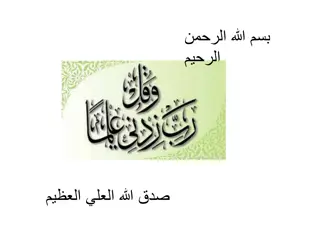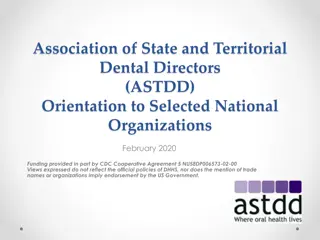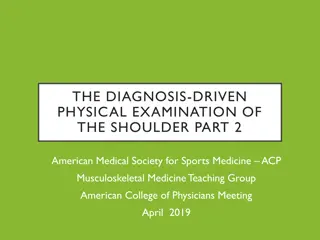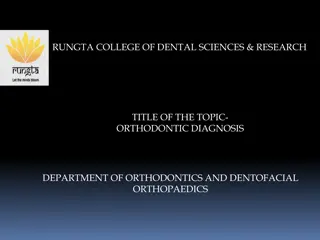Principles of Oral Diagnosis and Examination Techniques by Prof. Magdy K. Hamam
Prof. Magdy K. Hamam, a distinguished professor of Oral Medicine, outlines the principles of oral diagnosis and examination techniques in dentistry. The assessment of individual teeth, visual inspection, probing, and other evaluation methods are crucial for identifying dental issues such as caries, defects, trauma, and discoloration. Various conditions like attrition, abrasion, erosion, and abfraction are discussed along with their causes and effects on tooth structure.
Download Presentation

Please find below an Image/Link to download the presentation.
The content on the website is provided AS IS for your information and personal use only. It may not be sold, licensed, or shared on other websites without obtaining consent from the author. Download presentation by click this link. If you encounter any issues during the download, it is possible that the publisher has removed the file from their server.
E N D
Presentation Transcript
Prof. Magdy K. Hamam Prof . of Oral Medicine Faculty.ksu.edu.sa/prof.Hamam Principles of Oral Diagnosis: Gary C. Coleman John F. Nelson 1stEd (1993)
2 assessment must be made on examining the teeth :- A- assessment of each individual tooth . B- how the tooth is a part of a larger unit . ( cervical caries xerostomia ) Techniques and materials 1- Visual inspection , transillumination , probing , palpation , percussion and evaluation of function ) 2- A good light source , a mirror , a sharp explorer , and an air syringes 3- Additional adjuncts , ( dental floss , articulating paper , wooden pegs , heat Ice and electrical pulp tester . 4- final diagnosis ( radiograph & diagnostic casts ) 5- examination of the gingiva supporting structures of the teeth ( periodontal Probe )
Examination of teeth A- visual inspection ( orientation portion ( teeth present , missing , carious , discoloration , wear & dental malformation ) B- comprehensive dental examination of each tooth by visualization & probing charting for permanent 1 2 and 5 6 for deciduous teeth 4 3 7 8 Caries ( pit & fissure / smooth surfaces , chalky spots , cavitations ( explorer No.17 No. 5 , transillumination light , D. floss , radiograph / bitewing , per apical ) Defective restorations ( overhanging , open contact ) Defect or alteration of enamel ( enamel hypoplasia ) Congenital condition ( amelogenesis imperfecta ) Trauma or infection ( turner;s tooth ) Syphilis ( Hutchinson s teeth and mulberry molars ) Poor nutrition ( defeiciency in vitamins A , C, D ) Chemicals ( tetracycline and fluoride ) Exanthematous diseases ( measles , chicken pox & scarlet fever ) Discoloration & staining of teeth ( extrinsic or intrinsic factors . , chromogenic bacteria )
Loss of tooth structure Attrition loss of tooth structure due to friction facets ( physiologic - pathologic ) Attrition
Abrasion 2- Abrasion :- pathologic wearing away of dental hard tissue ( cervical area ) abrasion due to dentifrice , hard tooth brush
Erosion 3- Erosion :- loss of tooth structure due to chemical ( foods, candies , medication ,vomiting )
Abfraction 4- Abfraction :- loss of tooth structure due to bending forces ( lateral ) v- shape notches in teeth ( occlusal load stress cervical area cervical enamel rods to fracture & dislodge ( bruxism )
Pulp examination A pulp examination :- A- Percussion ( hand mirror No. 17 ) ( per apical percussion ,lateral percussion ) B- Thermal testing C- Electric pulp testing Thermal testing Heat ( worm gutta percha ) Cold ( small piece of ice or cotton sprayed with ethyl chloride ) In early pulpitis pain persists when the stimulus has been removed . Whereas in healthy pulp , the sensation disappears within 5 seconds . Pulp testing is difficult , communication between examiner and patient is important and the result must be interpreted carefully . For these reasons , all three means determining pulp vitality ( electrical current , heat , & cold ) are used .





